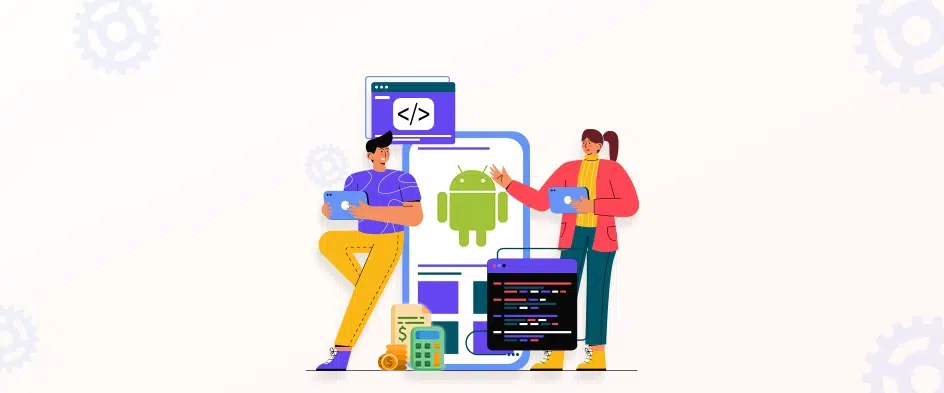Top 5 Software Development Trends for 2024

- 8 Minutes to read
Table of Content
- Trend #1: Artificial Intelligence & Machine Learning
- Trend #2: Agile and DevOps Practices
- Trend #3: Low-code and No-code Development
- Trend #4: Internet of Things (IoT) Integration
- Trend #5: Cybersecurity in Software Development
- Summary
- FAQs on Software Development Trends
Are you trying to develop a piece of software? Look around. There’s at least one (possibly hundreds of) software for anything and everything you can think of. So how do you stand out? Well, if you were to ask any of the top software development companies, the first thing to remember is to stay on top of the latest trends.
So what are the top software development trends? There’s AI & ML that can help you automate the processes, analyze data, and even improve the user experience. Then there’s cloud computing through platforms like AWS and Azure, for lowered costs, bigger storage, and improved performance. Other trends like IoT, Blockchain and more could also help.
Let’s check out the best software development trends one-by-one and see how they can help you create the best piece of software for your target audience. Without further ado, let’s begin.
Trend #1: Artificial Intelligence & Machine Learning
When we talk about trends in any sort of software or web development, the first one that comes to mind is AI & ML. They offer various benefits such as enhanced automation, improved accuracy, and intelligent decision-making capabilities. That’s why companies are actively adopting these technologies to optimize their software dev processes and achieve better results.
AI algorithms process big datasets, spot patterns, and make forecasts. ML algorithms gain from data to boost their effectiveness continuously. Moreover, AI algorithms can improve software performance by modifying parameters depending on immediate feedback. For example, they can scale resources in cloud apps to guarantee the best performance even with varying workloads. This leads to more cost-effective and efficient software solutions.
Also, AI and ML make user experience better by offering individualized suggestions based on user preferences and behavior. They can suggest appropriate services or content tailored to every user’s necessities, resulting in higher customer satisfaction.
Benefits of AI and ML in Software Development
| Benefits | Description |
|---|---|
| Automation | AI & ML algorithms can be used to automate a wide range of tasks like code generation, code review, unit testing, bug detection, software testing, and deployment and maintenance. That frees up developers to focus on more strategic and creative work. |
| Enhanced Accuracy | AI-powered code review tools can detect potential bugs and security vulnerabilities more accurately than human reviewers. AI-powered unit testing tools can generate and execute test cases more efficiently and accurately than traditional unit testing tools. |
| Intelligent Decision-Making | AI-powered project management tools can help teams to allocate resources more effectively and to identify and mitigate risks more proactively. AI-powered product development tools can help teams to gather and analyze user feedback more efficiently and to identify and prioritize new features more effectively. |
Applications of AI & ML in Software Development
| Application | Description |
|---|---|
| Code Generation | AI algorithms can study already existing codebases and generate new code based on patterns and best practices. This saves developers time and energy. |
| Bug Detection | ML models can detect bugs in code by analyzing past data and noticing common mistakes. This assists in improving software quality. |
| Automated Testing | AI systems can test software applications automatically, detect bugs and provide detailed reports for developers to fix them quickly. |
| Natural Language Processing | ML algorithms allow software systems to comprehend and interpret human language, making it easier to develop chatbots, voice assistants, and language-based applications. |
| Predictive Analytics | AI can forecast future trends or behavior patterns by studying a lot of data, permitting developers to make informed decisions during the development process. |
In short, using AI and ML in software development can boost productivity while maintaining higher standards of code quality and user experience.
Trend #2: Agile and DevOps Practices
The emergence of Agile and DevOps practices is a significant trend in software development. These practices involve a collaborative approach between software development and operations teams, with a focus on continuous integration, delivery, and deployment.
Agile methodology has an emphasis on flexibility and responding to changes. Sprints divide development cycles, with each delivering a working product increment. Daily stand-ups help with communication between team members. Scrum and Kanban aid in task prioritization, plus workload management.
DevOps works to bridge the gap between developers and IT operations. This helps with faster software delivery. CI/CD practices let developers automate code building, testing and deployment. This reduces errors, raises software quality, plus accelerates time-to-market. Jenkins, Docker, plus Kubernetes are tools that help streamline processes.
Benefits of Agile and DevOps in Software Development
| Benefit | Description |
|---|---|
| Better Collaboration | Agile and DevOps make communication and teamwork more efficient, ultimately increasing coordination and productivity. |
| Faster Time-to-Market | By allowing iterative development and continuous integration, Agile and DevOps speed up software releases. |
| Increased Customer Satisfaction | With Agile, customers give feedback regularly, guaranteeing software meets expectations, raising satisfaction. |
| Greater Quality | Automated testing within development enables Agile and DevOps to detect issues quickly, resulting in better software. |
| More Flexibility | Agile methods prioritize adaptability, allowing changes throughout development, making teams able to respond quickly to changing requirements or market needs. |
| Smarter Resource Management | With increased visibility from tools like Kanban boards and burndown charts, Agile and DevOps help allocate resources in the most efficient way possible. |
Moreover, Agile instills cross-functional teams where individuals take responsibility for different parts of a project. This enhances accountability and promotes knowledge sharing. Additionally, DevOps practices encourage a culture of collaboration between development and operations teams.
By removing silos and strengthening shared responsibility for software delivery and maintenance, organizations can achieve continuous improvement.
Trend #3: Low-code and No-code Development
Low-code and no-code development involves the use of visual interfaces and pre-built components to create applications, reducing the need for traditional coding. This trend has gained traction as it enables non-technical individuals to participate in the development process, accelerating the overall speed of app creation.
The best software development agencies use this tactic to streamline their workflow, saving time and resources.
| Low-Code Development | No-Code Development | |
|---|---|---|
| Ease of Use | High | Very High |
| Technical Skills | Minimal | None |
| Customization | Limited | High |
| Time Savings | Moderate | Significant |
| Flexibility | Moderate | High |
This table presents a comparison between low-code and no-code development. It highlights the ease of use and the level of technical skills required for each approach, as well as the level of customization, time savings, and flexibility they offer.
Benefits of Low-Code and No-Code Development
| Benefits | Description |
|---|---|
| Quick App Building | With low-code and no-code, users can quickly put together apps by dragging and dropping pre-built parts. This trims down the time and effort of traditional coding. |
| Open to All | These tools let people with no tech background join development. They provide a visual interface and simplified workflows, giving more users the ability to make their own apps. |
| More Productive | Low-code and no-code gets rid of the need for extensive programming know-how. So, business pros can prototype, test, and improve their ideas faster, leading to more productivity in organizations. |
| Customizable and Flexible | Low-code and no-code platforms have many pre-built templates and integrations, which let users customize their applications to their needs. This gives businesses the ability to craft tailored solutions fast. |
| Smart Collaboration | These development approaches boost collaboration between tech and non-tech teams. Working together on these platforms lets them tackle problems more effectively, meaning better agility for the organization. |
To get the best out of low-code and no-code development, follow these tips:
- Check Use Cases: Before starting on apps, check the various uses in your org where low-code and no-code can be helpful. Pick projects based on feasibility, impact, and potential ROI.
- Train Teams: While it’s not necessary to have tech knowledge, offering training sessions can help users take full advantage of low-code and no-code development. Enhancing their skills lets them make more complex apps.
- Regularly Assess Platforms: With more and more low-code and no-code platforms, you must regularly assess the options on the market. Choose platforms that fit your org’s goals, scale up easily, and provide strong support.
- Promote Collaboration: Stimulate collaboration between tech and non-tech teams in the app development process. Include stakeholders from various departments to make sure you have diverse views and a holistic approach.
Low-code and no-code development tools often provide a range of templates and pre-configured functionalities. These tools enable developers to rapidly build and deploy applications, reducing the development lifecycle even further. This trend is especially good for small businesses and startups that require fast and cost-effective solutions.
Trend #4: Internet of Things (IoT) Integration
As technology advances, the integration of Internet of Things (IoT) in software development is becoming increasingly prominent. This trend encompasses the incorporation of IoT devices and networks into software systems, enabling enhanced connectivity and functionality.
| Aspects | Description |
|---|---|
| Connectivity | Integration of IoT devices and networks for seamless data exchange |
| Security | Implementing robust measures to protect IoT systems against threats |
| Scalability | Designing software that can handle large-scale IoT deployments |
| Real-time | Enabling instant data processing and analysis for real-time insights |
| Interoperability | Ensuring compatibility between different IoT devices and platforms |
This digital age has made IoT a key part of software development. Developers are confronted with fresh challenges and opportunities due to the abundance of connected devices. One great advantage of IoT integration is the capacity to access large amounts of data from multiple sources, which can be used to gain precious insights and make informed decisions.
Moreover, IoT integration makes it possible to build smart applications that can communicate with each other easily. For instance, a smart home system can connect to various devices like thermostats, surveillance cameras, and lighting fixtures to create an automated and personalized environment.
Plus, IoT integration opens up limitless possibilities in industries such as healthcare, manufacturing, transportation, and agriculture. In healthcare, IoT devices can remotely monitor patients and notify doctors in case of emergencies. In manufacturing, IoT sensors can monitor equipment performance and schedule maintenance in advance.
Examples of IoT Integration in Software Development
| Healthcare | Wearable fitness trackers are now common. They can monitor patient vital signs remotely and alert medical staff in time. |
| Manufacturing | Smart sensors in machinery collect performance data. This optimizes production and predicts maintenance needs. |
| Transportation | Connected vehicles use IoT to get info on road conditions and traffic. They can send safety warnings to drivers. |
| Retail | RFID tags and beacons help retailers track inventory accurately. This gives real-time updates and enhances the customer shopping experience. |
| Energy | Smart meters measure energy consumption, helping to manage resources and save costs. |
The significance of IoT in software development cannot be overstated. Its integration enables organizations to tap into the power of connected devices and unlock new opportunities for creativity.
Trend #5: Cybersecurity in Software Development
Cybersecurity is quite a common term in software and web development. It involves implementing robust security measures to safeguard confidential information and prevent unauthorized access or breaches.
It’s worth noting that cybersecurity in software development is not a one-time task but an ongoing process. It requires staying up-to-date with the latest security practices, conducting regular audits, and continuously enhancing protective measures.
By maintaining a proactive approach towards cybersecurity, developers can effectively identify and address potential vulnerabilities, reducing the security breach risks and ensuring the overall integrity of software applications.
Here’s are a few cybersecurity implementations you can go for:
- Encrypting data when at rest and in motion is also an essential part of making secure software. This ensures that information is private and protected from unauthorized interception or changing.
- Including strong authentication approaches like multi-factor authentication gives extra safety. This guarantees that the people accessing the software are verified and blocks unauthorized access by bad actors.
- Encryption is vital for safeguarding data during transmission and storage. Sensitive data becomes unreadable using algorithms. Secure coding practices like input validation and output encoding help mitigate common vulnerabilities.
- Access controls prevent unauthorized access to the system. Techniques like authentication, authorization, and user permissions ensure only authorized individuals can access data or functionalities.
- Regular vulnerability assessments and penetration testing identify potential weaknesses in the system architecture or code. This way, developers can proactively address those issues before they’re exploited by malicious actors.
- IDS and IPS systems monitor network traffic to detect suspicious activities and block/alert admins about potential attacks.
It is also necessary to stay informed about the newest security flaws and patches. Developers should keep track of new flaws and apply patches regularly to prevent any security risks.If you want to implement any of these trends on your software project, I suggest you look for the best software development service providers. They’ll analyze your project requirements and implement these trends on your piece of software effectively
Summary
Continuous learning and adaptability are key in this tech realm. As new tools and frameworks appear, developers must stay up-to-date. This enables them to use innovative approaches and optimize their software processes for efficiency and productivity. Here are a few of the best software development trends.
- Artificial Intelligence & Machine Learning
- Agile & DevOps Practices
- Low-Code and No-Code Development
- Internet of Things (IoT) Integration
- Cybersecurity
Staying proactive with these trends is essential. Failing to do so can mean falling behind competitors or missing out on growth opportunities. If you want to learn more about improving software development or how you can use the latest practices, stay tuned for our blogs.
FAQs on Software Development Trends
1. How do low-code and no-code development platforms work?
Low-code and no-code development platforms enable the creation of software applications with minimal coding efforts. These platforms utilize visual interfaces, drag-and-drop functionality, and pre-built components to allow users to build applications by connecting and configuring different modules.
This approach accelerates the development process and empowers business users with limited coding knowledge to develop applications.
2. What is cloud-native development?
Cloud-native development refers to an approach where software applications are built specifically for cloud environments. It involves designing applications as a collection of loosely coupled services or microservices that can be deployed and scaled independently.
Cloud-native development leverages cloud technologies and platforms to deliver higher scalability, availability, and resilience.
3. How do containers and microservices architecture enhance software development?
Containers and microservices architecture enhance software development by enabling greater scalability, flexibility, and modularity. Containers allow applications to be packaged with their dependencies, ensuring consistency across different environments.
Microservices architecture breaks down applications into small, independent services that can be developed, deployed, and maintained separately. This approach promotes agility, fault isolation, and easier scalability.



